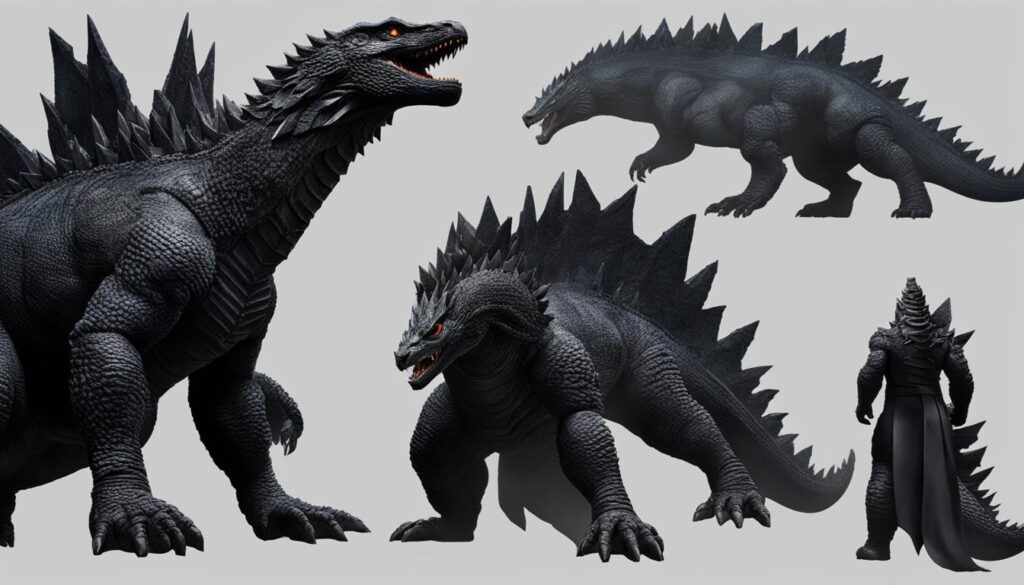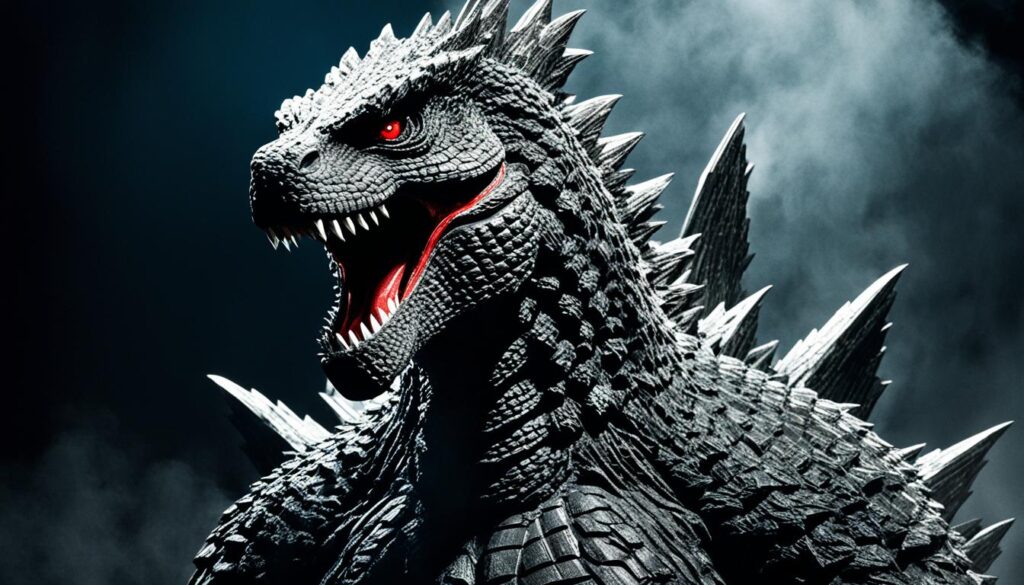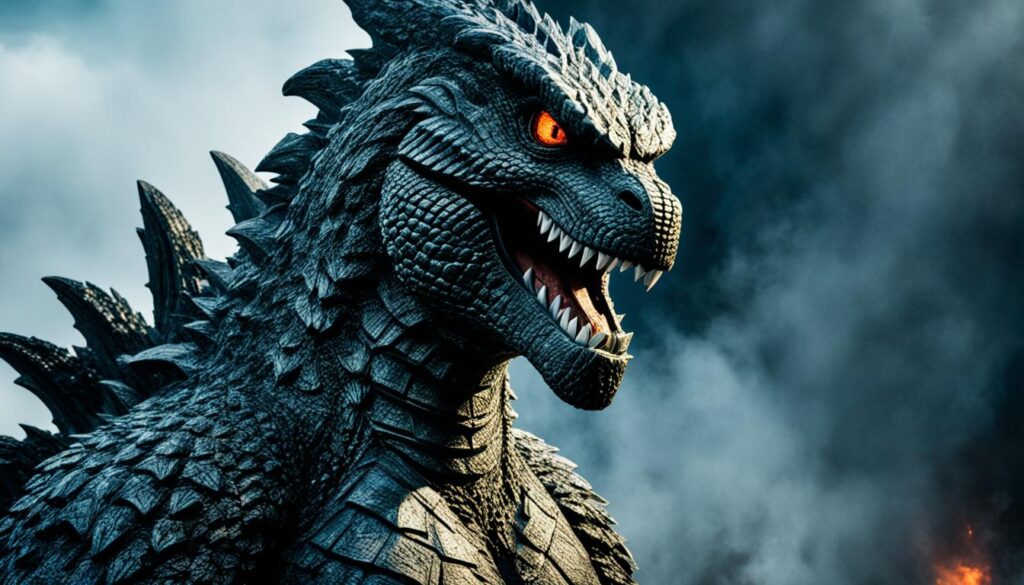Welcome to our exploration of the legendary figure known as the Man in the Suit Godzilla. In this article, we delve into the fascinating world of the iconic Japanese monster, its groundbreaking suit, and the impact it has had on the kaiju film genre, as well as special effects in cinema.
The Man in the Suit Godzilla refers to the late Haruo Nakajima, the talented actor who brought the original Godzilla to life in the 1954 film. Nakajima’s portrayal revolutionized the genre, showcasing the power of practical effects and the artistry behind creating a memorable monster.
Wearing a cumbersome rubber suit, Nakajima embodied the essence of the creature, conveying not only its destructive physicality but also the complex themes it symbolized. The character of Godzilla emerged as an allegory for the nuclear era, resonating with postwar Japan and capturing the imagination of audiences worldwide.
Join us as we explore the birth of the Man in the Suit Godzilla, the evolution of its design, and the enduring legacy left by both Haruo Nakajima and the iconic character. Let us uncover the cultural significance and lasting impact of this extraordinary Japanese monster.
The Birth of the Man in the Suit Godzilla
Haruo Nakajima, initially a stunt actor in samurai films, was approached to take on the role of Godzilla. The character quickly became Japan’s most successful cultural export in the realm of monster films. Nakajima’s version of Godzilla, portrayed in the rubber suit, resonated with fans who preferred this portrayal over some of the Hollywood depictions.
Nakajima developed the character by studying how elephants and bears moved at zoos, emphasizing the importance of proper walking and conveying the pathos of the creature. The original Godzilla film, directed by Ishiro Honda with a memorable score by Akira Ifukube, struck a chord with postwar Japan, addressing universal human problems and highlighting the country’s wartime suffering.
Evolution of the Godzilla Designs
The evolution of the Godzilla designs can be traced back to the 1954 film, where the first official Godzilla suit design, known as ShodaiGoji, was introduced. This groundbreaking design not only set the template for future Godzilla incarnations, but also became an iconic representation of the creature.
The ShodaiGoji suit featured a reptilian creature with rough, bumpy scales, muscular arms, thick legs, and three rows of dorsal plates. The large head with prominent eyebrows added to the intimidating presence of the monster.
This first official design heavily influenced all subsequent Godzilla designs, establishing the distinctive look that has become synonymous with the character.
The ShodaiGoji suit was constructed using raw rubber, soaked in water and mixed with a batter of vaseline, clay, and gypsum. The resulting suit, although heavy and restrictive for the actors inside, brought Godzilla to life on the screen with its realistic appearance.

Despite its limitations, the rubber suit monster captured the imagination of audiences and became a beloved and enduring representation of the iconic Japanese monster. The design of the original Godzilla suit remains an integral part of the tokusatsu series and continues to inspire future renditions of Godzilla.
Haruo Nakajima’s Legacy and Impact
Haruo Nakajima, the legendary actor who portrayed Godzilla in the iconic rubber suit, left an indelible mark on the kaiju film genre and the world of special effects. Over the span of a decade, Nakajima donned the Godzilla costume in twelve films, captivating audiences with his dedication and physical performance.
Nakajima’s portrayal of Godzilla became the face of the franchise, influencing numerous sequels and spin-offs both within Japan and internationally. His embodiment of the monstrous creature brought a sense of realism and authenticity to the character, capturing the imagination of fans around the world.
His work at Toho Studios, the production company behind Godzilla, revolutionized the way monster movies were made. Nakajima’s understanding of the suit’s limitations and his ability to convey emotion through physicality added depth and complexity to the character. His contributions to Japanese cinema and the special effects industry cannot be overstated.
Through Nakajima’s portrayal, Godzilla evolved from a simple monster onscreen to a symbol of nuclear fears and postwar Japan’s collective trauma. He brought the character to life, allowing audiences to connect emotionally with Godzilla’s grandeur and complexity.
“My main concern was how to make Godzilla appear as a creature over 50 meters tall, but I wanted to make audiences sit there in awe and believe that this Godzilla really existed,” Nakajima once said, emphasizing the earnestness and dedication he brought to his performance.
His legacy reaches far beyond the realm of kaiju films. Nakajima’s Godzilla remains an iconic figure in popular culture, inspiring future filmmakers to explore the possibilities of practical effects and creature features. His impact on cinema history is immeasurable, solidifying his place as one of the greats in the industry.
Acknowledging Nakajima’s Pioneering Role
Nakajima’s work paved the way for future actors and performers in rubber suit monsters and tokusatsu series, influencing a generation of filmmakers and special effects artists. His dedication and physicality as Godzilla set the standard for the portrayal of larger-than-life creatures onscreen, leaving a lasting legacy that continues to resonate today.
| Key Contributions | Impact |
|---|---|
| Revolutionized kaiju films and special effects in Japanese cinema | Elevated the genre and inspired filmmakers worldwide |
| Brought a sense of realism and emotion to the Godzilla character | Connected with audiences on a deeper level |
| Influenced future actors and performers in rubber suit monsters | Pioneered the way for future generations |
Godzilla’s Continuing Legacy
The Godzilla franchise has continued to thrive, captivating audiences with a mix of Japanese and U.S.-made films. Among these, the most recent Toho-produced Godzilla film was released in 2016, showcasing the enduring popularity and cultural significance of the iconic Japanese monster. With each new installment, Godzilla has solidified its status as an international symbol, representing both the destructive power of nature and society’s deepest fears.

From its origins in the rubber suit monster of the 1954 film to the cutting-edge special effects of today, the legacy of Godzilla endures. Toho Studios, the creative force behind the franchise, has kept the spirit of the man in the suit Godzilla alive, ensuring that the character remains a beloved and enduring cinematic icon.
Godzilla in Popular Culture
Godzilla’s popularity extends far beyond the confines of the silver screen, infiltrating various aspects of popular culture. The iconic image of the man in the suit Godzilla wreaking havoc through cities has become synonymous with Japanese monster movies and captivated audiences worldwide.
In addition to its film presence, Godzilla has made appearances in numerous short films, web series, and video games, further fueling the imagination of fans in every corner of the globe. The character’s larger-than-life persona and destructive power continue to enthral and entertain audiences across various media.
Godzilla’s influence has also extended into literature, with the character being featured in books that explore the depths of its mythology and the impact it has had on society. Furthermore, Godzilla has become a prominent figure in advertising campaigns, adding a touch of monster-sized excitement to commercials and promoting various brands.
“Godzilla has transcended the boundaries of cinema, cementing its place in popular culture and leaving an indelible mark on our collective imagination.” – Marketing Director
Merchandise featuring the man in the suit Godzilla has played a significant role in solidifying its status as a pop culture icon. From action figures and apparel to collectibles and home decor, fans can proudly display their love for the Japanese monster and keep its legacy alive.
The enduring popularity of Godzilla highlights its cultural significance and the widespread appeal of kaiju films. The character continues to inspire filmmakers, artists, and storytellers, ensuring that the man in the suit Godzilla remains a formidable force in popular culture for generations to come.

The Influence of Godzilla Design
The original ShodaiGoji design of Godzilla’s suit heavily influenced subsequent designs for the character. The iconic look of Godzilla, with its rough scales, muscular build, and distinctive dorsal plates, has become synonymous with the creature. The attention to detail and craftsmanship in creating the rubber suit allowed for a realistic portrayal of Godzilla on screen, capturing the imagination of audiences around the world.
The influence of the man in the suit Godzilla is evident in the enduring popularity and recognition of the character’s design.

| Features | Description |
|---|---|
| Rough scales | The rough texture of Godzilla’s scales adds to its menacing appearance and gives it a reptilian charm. |
| Muscular build | The muscular physique of Godzilla conveys its immense power and size, reinforcing its status as a formidable force. |
| Distinctive dorsal plates | The unique arrangement of Godzilla’s dorsal plates sets it apart from other monsters and adds to its iconic silhouette. |
The influence of the man in the suit Godzilla is also seen in the countless homage and parodies of the character in popular culture. From movies to video games, Godzilla’s design has become instantly recognizable, representing the epitome of a rubber suit monster. The enduring popularity of Godzilla’s design is a testament to the lasting impact of the original ShodaiGoji suit and the craftsmanship behind it.
Godzilla’s Place in Film History
Godzilla’s impact on film history is profound and far-reaching. The release of the original 1954 film created a new genre of kaiju films, captivating audiences with its groundbreaking special effects techniques. Through the man in the suit Godzilla, the character was brought to life with a physicality and presence that resonated with viewers and set a standard for future monster movies.
“The success of the Godzilla franchise paved the way for the creation of other iconic monsters and inspired filmmakers around the world to explore the possibilities of creature features and the use of practical effects.”
Godzilla’s place in film history cannot be overstated. The enduring popularity of the character has solidified its status as a cultural phenomenon. The success of the franchise led to numerous sequels, spin-offs, and reboots, all of which showcased the enduring legacy of the man in the suit Godzilla. Through its influence on the film industry, Godzilla has become a symbol of the power of practical effects and the enduring appeal of larger-than-life monsters.
The Impact of Godzilla’s Place in Film History
The success of the Godzilla franchise had a profound impact on the film industry and popular culture. It introduced groundbreaking special effects techniques that revolutionized the way monsters were portrayed on screen. The use of practical effects and the man in the suit Godzilla set a new standard for realism and physicality in monster movies.
Godzilla’s enduring popularity led to the creation of other iconic monsters, solidifying the kaiju film genre as a significant part of cinematic history. Filmmakers around the world were inspired by the success of Godzilla, leading to the creation of their own monster movies and exploration of practical effects. The legacy of the man in the suit Godzilla lives on, reminding us of the power of practical effects in creating unforgettable cinematic experiences.
| Godzilla’s Impact on Film History | Details |
|---|---|
| Genre Creation | The original 1954 Godzilla film created a new genre of kaiju films, captivating audiences with its unique blend of science fiction and monster elements. |
| Revolutionizing Special Effects | The use of practical effects and the man in the suit Godzilla introduced groundbreaking techniques that set a new standard for realism and physicality in monster movies. |
| Inspiring Filmmakers Worldwide | The success of the Godzilla franchise inspired filmmakers around the world to explore the possibilities of creature features and practical effects, leading to the creation of other iconic monsters. |
| Cultural Phenomenon | The enduring popularity of Godzilla solidified its status as a cultural phenomenon, with the character becoming a symbol of practical effects and larger-than-life monsters. |
Godzilla’s place in film history is a testament to the enduring power of practical effects and the creativity of filmmakers. The man in the suit Godzilla brought a physicality and realism to the character that captivated audiences and set a new standard for monster movies. As we look back on the legacy of Godzilla, we are reminded of the impact it has had on the film industry and its lasting cultural significance.
Remembering Haruo Nakajima
Upon Haruo Nakajima’s passing, fans and the film industry mourned the loss of the man who first brought Godzilla to life. Nakajima’s dedication to his craft and his portrayal of Godzilla left an indelible mark on cinema history. He will always be remembered as the actor who wore the rubber suit and breathed life into the iconic Japanese monster. Nakajima’s contributions to kaiju films, special effects, and Japanese cinema are lasting legacies that will continue to captivate and inspire future generations.
Haruo Nakajima’s portrayal of Godzilla revolutionized the kaiju film genre. By donning the cumbersome rubber suit, Nakajima brought a physicality and presence to the character that resonated with audiences. His dedication to studying the movements of real animals, such as elephants and bears, enabled him to capture the essence and pathos of the creature. Nakajima’s performance inside the Godzilla costume showcased the artistry of practical effects and highlighted the immense talent that goes into bringing a fictional monster to life.
“Nakajima’s performance in the Godzilla suit set the standard for future kaiju films and influenced generations of filmmakers and special effects artists.” – Toho Studios
Throughout his career, Nakajima wore the Godzilla costume in a total of twelve films, cementing his legacy as the definitive Godzilla actor. His portrayal of the iconic Japanese monster captivated audiences and spawned a franchise that continues to thrive today. Godzilla’s enduring popularity is a testament to Nakajima’s talent and the timeless appeal of the character he helped create.
The Impact on Toho Studios
Nakajima’s work on Godzilla at Toho Studios catapulted the studio to international recognition. The success of the franchise allowed Toho to invest in other kaiju films and solidify its position as a leader in the genre. The Godzilla series became a cornerstone of Toho’s catalog, with the rubber suit monster symbolizing the studio’s commitment to blending compelling storytelling with groundbreaking special effects.
Legacy in Japanese Cinema
- Nakajima’s Godzilla became an iconic symbol of postwar Japan, reflecting the nation’s fears and anxieties.
- His portrayal of the monster addressed deeper human problems, transcending a simple creature feature.
- Godzilla’s journey from destructive force to protector of humanity captivated audiences and highlighted the complexities of the human condition.
Inspiring Future Generations
Haruo Nakajima’s groundbreaking portrayal of Godzilla continues to inspire filmmakers and special effects artists around the world. His work paved the way for advancements in practical effects and demonstrated the power of blending physical performance with imaginative storytelling. Nakajima’s legacy as the man in the suit Godzilla will forever be remembered as a testament to the artistry and creativity of the film industry.
Conclusion
The man in the suit Godzilla, Haruo Nakajima, has left an indelible mark on the world of cinema. His physical portrayal of the iconic Japanese monster revolutionized kaiju films and showcased the power of practical effects. Nakajima’s dedication inside the rubber suit brought Godzilla to life in a way that continues to captivate audiences today.
His legacy lives on in the enduring appeal of larger-than-life monsters and the recognition of Godzilla as a cultural icon. The man in the suit Godzilla has become synonymous with the kaiju film genre, and his contributions to the special effects industry cannot be understated.
From his humble beginnings as a stunt actor to becoming the face of Godzilla, Nakajima’s work has influenced filmmakers and inspired a new generation of monster movie enthusiasts. His portrayal of the man in the suit Godzilla remains a legendary figure in cinema, reminding us of the power of practical effects and the timeless allure of Japanese monsters.